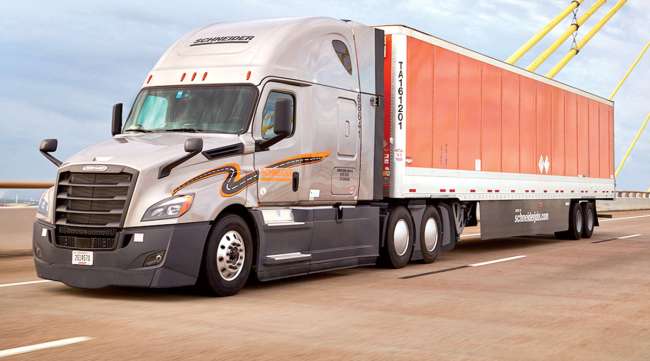Staff Reporter
Schneider Reports Revenue Decline of 8% to $1.32B for Q1

[Stay on top of transportation news: Get TTNews in your inbox.]
Schneider experienced a year-over-year decline in revenue to $1.32 billion during the first quarter of 2024, the company reported May 2.
The Green Bay, Wis.-based truckload motor carrier posted net income of $18.5 million, or 10 cents a diluted share, for the three months ending March 31. That compared with $98 million, 55 cents, during the same time the previous year. Total operating revenue decreased by 8% to $1.32 billion from $1.43 billion.
The results were slightly below expectations of investment analysts on Wall Street, who had been looking for quarterly revenue of $1.37 billion, 13 cents, according to Zacks Consensus Estimate. Schneider ranks No. 8 on the Transport Topics Top 100 list of the largest for-hire carriers in North America and No. 21 on the TT Top 100 list of the largest logistics companies.
“In the first quarter, the excess capacity condition persisted,” Schneider CEO Mark Rourke said during a call with investors. “January was especially challenging with sluggish volumes and adverse winter weather, which negatively impacted a large portion of the network. We are assessing signs that market conditions are beginning to moderate.”
Rourke added that there were positive contract price renewal closures in the low single digits for the truckload network for the first time in six quarters. He said this has been a promising sign, but it hasn’t been enough to indicate the market is at an inflection point.
“In the first quarter, the outcomes of pricing renewals varied across our service offering,” Rourke said. “We achieved positive pricing and volume share gains with some large strategic customers as they prepare for the next market phase. We also renewed with certain customers at reduced volumes, if retaining volume required contractual price concessions.”
Rourke noted the company is prepared in the short term to place more of its capacity in other configurations, including dedicated and the spot market. He said this approach has positioned the company to quickly pivot and leverage its scale across its multimodal platform for when the market improves.
“1Q came in line with expectations which we view as a positive given the TL group results thus far,” TD Cowen analyst Jason Seidl wrote in a report. “[Management] lowered its full-year guidance, as we expected and previously modeled, and still sees modest sequential improvements throughout the year with recent contractual renewals being in the black. SNDR expects strength in intermodal volumes to continue and outpace [over the road.]”
Truckload segment revenue increased 0.2% to $538.1 million from $537 million during the same time last year. The results were driven by dedicated organic and acquisitive growth. But this was somewhat offset by lower network pricing and volumes year-over-year. Truckload revenue per truck per week decreased of 4%. Income from operations decreased 76% to $14.9 million from $62.6 million. This was due to pricing and volume pressures in network.
“In truckload network, revenue per truck per week in the first quarter contracted 10% year-over-year, with most of the change due to depressed rates,” Rourke said. “[The] majority of the year-over-year and sequential changes to network truck count is centered around the owner-operator community, which highlights the financial strain that small operators are enduring ... through this extended down cycle.”
Intermodal segment revenue decreased 7% to $247.2 million from $266.1 million. This was primarily driven by decreased revenue per order. The report noted first-quarter volumes were flat compared to the same period a year ago. Intermodal income from operations decreased 77% to $7 million from $30 million. This also was primarily due to lower revenue per order.
“Moving to the intermodal segment, volumes were flat year-over-year,” Rourke said. “Revenue per order was down 7% compared to the first quarter a year ago. Intermodal margins improved 40 basis points sequentially from the fourth quarter, overcoming typical seasonal declines and more severe weather impacts. The intermodal network is showing modest signs of healing, with new business awards being implemented and dray cost efficiency gains. Intermodal first-quarter contractual renewals were largely flat compared to a year ago.”
Check out Transport Topics' updated Top 100 list of the largest logistics companies in North America, and explore how the industry's top players have adapted to a tough freight market and are preparing for the future. Tune in above or by going to RoadSigns.ttnews.com.
Rourke considers the flat contractual renewals to be favorable given the prior first-quarter renewals were the most constructive of 2023. But he pointed out that the outcomes of the early renewal season were more volatile than is typical.
Logistics segment revenue decreased 15% to $324.9 million from $382.2 million. This was driven by decreased revenue per order and lower brokerage volume because of muted freight conditions. Income from operations decreased 71% to $5.4 million from $18.5 million. The decrease was largely driven by lower brokerage volumes and net revenue per order.
“In our logistics segment, we have observed that customers, in general, are favoring asset-based solutions,” Rourke said. “We have seen the favorability for our assets and asset-based brokerages play out in the first quarter, as our overall brokerage order volumes contracted only 8% year-over-year, and power-only order volumes grew each month through the quarter and year-over-year.”
Want more news? Listen to today's daily briefing below or go here for more info:





